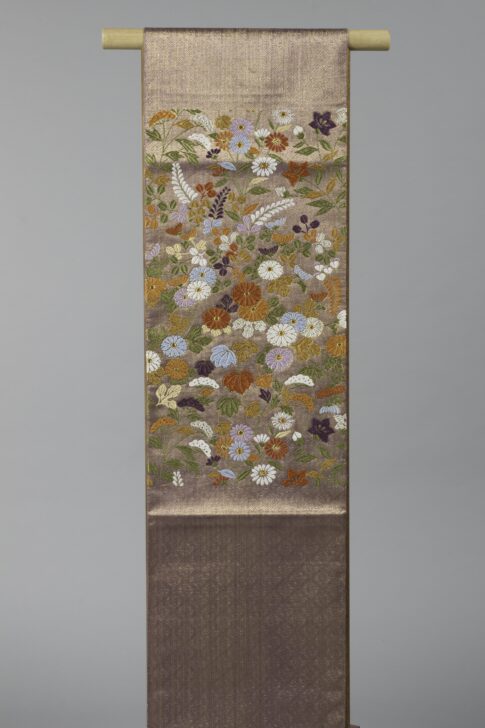Obi
Japanese

Description
Rimpa School
Haori
Japan, Showa period (1926–89)
Mid- to late–20th century
Silk
Gift of Mrs. Kazuko Miyake, 2016/2.74
Obi
Japan, Showa period (1926–89)
Mid- to late–20th century
Silk
Gift of Mrs. Kazuko Miyake, 2016/2.58
The striking design of this haori and obi are inspired by the Rimpa
School, an artistic tradition known for its bold use of color, motifs
abstracted from nature, and asymmetrical compositions. A haori is a
traditional Japanese hip or thigh length jacket with elongated sleeves,
worn over a kimono. Originally part of a man’s formal attire, in the
nineteenth century, female entertainers in Edo (modern Tokyo) adopted
it as a cloak for outdoor wear in mild weather. By the end of the century,
married women of the upper class had adopted black crepe silk haori
with family crests for formal, public occasions. For much of the twentieth
century, the haori has been the standard outerwear for a woman who
dresses in a kimono outside the home.
The obi is made of textiles developed in the Nishijin area of Kyoto, which
have dominated the market for high-quality woven textiles in Japan since
the fifteenth century. The production of Nishijin textiles is complex
and specialized in five main areas—designing and creating patterns,
producing silk threads, producing tools (including weaving machines),
weaving, and final sewing—each executed in a different workshop.
Summer 2022 Gallery Rotation
Subject Matter:
This is a Nishiki, Nishijin, and fukuro obi in rokutsuu gara.
Fukuro Obi is double-layered single sided obi in which two separately woven surfaces and back pieces of cloth are stitched together. This type of obi is typically only worn at weddings or other formal occasions.
Nishijin-ori textiles were developed in the Nishijin area of Kyoto city and has dominated the production of high-quality woven textiles since the fifteenth century. The production of Nishijin textiles is very complex and is specialized in five main areas—designing and creating patterns, producing silk threads, producing tools (including weaving machines), weaving, and final sewing—each executed in a different workshop.
Nishiki is a type of vibrant silk brocade with vivid and luxurious images using various colorful and metallic (mainly gold and silver). Nishiki brocade is mainly produced in the Nishijin area of Kyoto.
Gara refers to the orientation, arrangement, and surface area of the patterns and pertains to a specific trend and obi tying style. The Rokutsuu gara type derives from a specific tying style, the Otaiko musubi. The areas of the obi that are visible in this style are patterned while the parts that are obscured are left blank. In terms of surface area, roughly sixty percent is patterned while forty percent is left blank.
Physical Description:
lavender and gold fukuro (single-sided) obi with interwoven geometric modified sauvastika (reverse swastika) motif patterning called “sayagata” in Japanese with embroidered chrysanthemums, wisteria, and paulownia leaf motifs in various colors.
Usage Rights:
If you are interested in using an image for a publication, please visit https://umma.umich.edu/request-image/ for more information and to fill out the online Image Rights and Reproductions Request Form.